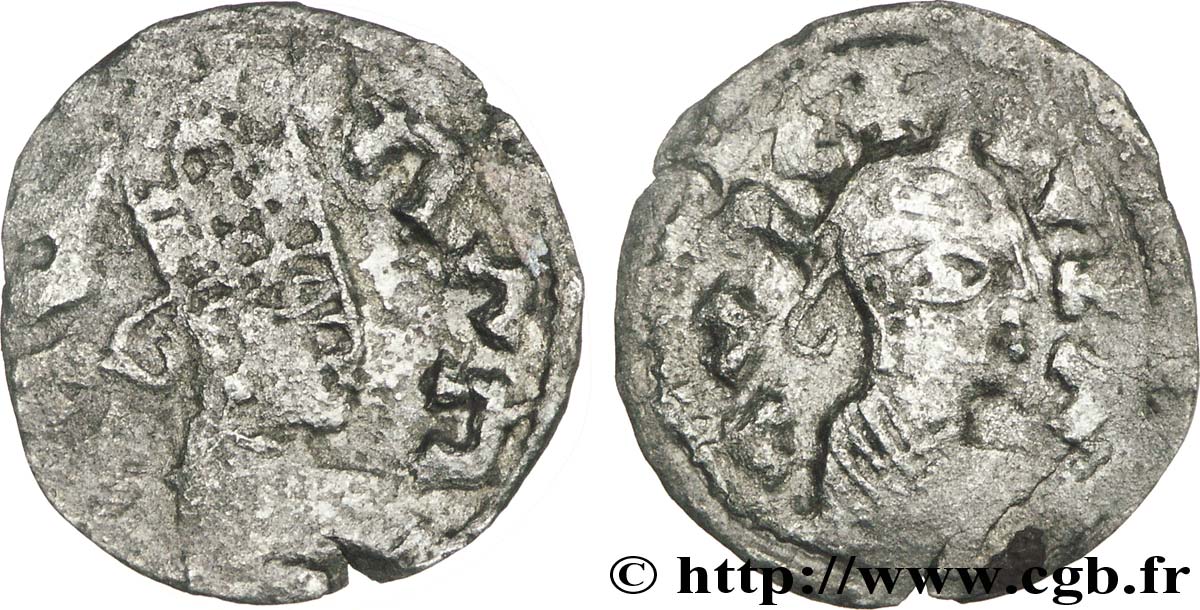v29_0794 - AKSUM - AKSUMITE KINGDOM - KALEB Monnaie d’argent aux portraits
MONNAIES 29 (2007)
Starting price : 200.00 €
Estimate : 320.00 €
Realised price : 250.00 €
Number of bids : 2
Maximum bid : 460.00 €
Starting price : 200.00 €
Estimate : 320.00 €
Realised price : 250.00 €
Number of bids : 2
Maximum bid : 460.00 €
Type : Monnaie d’argent aux portraits
Date: n.d.
Metal : silver
Diameter : 14,3 mm
Orientation dies : 12 h.
Weight : 0,68 g.
Rarity : R1
Coments on the condition:
Monnaie de frappe un peu molle sur un flan légèrement irrégulier, mais avec une surface irrégulière et granuleuse
Catalogue references :
Obverse
Obverse legend : LÉGENDE EN GE’EZ.
Obverse description : Buste diadémé et drapé à droite, légende autour ; grènetis.
Obverse translation : (Roi Kaleb).
Reverse
Reverse legend : LÉGENDE EN GE’EZ.
Reverse description : Buste drapé à droite, la chevelure recouverte d'un bonnet décoré sur sa partie avant ; légende autour ; grènetis.
Commentary
Sur ce type 111, les légendes ne sont plus en grec mais entièrement en ge'ez. Au revers, la légende de propagande décrit le roi mentionné au droit comme "donnant satisfaction à la ville et convenant au pays".
Les premières inscriptions en ge'ez (langue sémitique officielle de l'empire d'Axoum) datent du IVe siècle de notre ère. Un dialecte emprunté au ge'ez, l'amharique, prit le relais (dynastie de Choa). On ajouta de nouveaux caractères à l'ancien syllabaire. Ce système a une grande ressemblance avec les écritures de l'Inde où la voyelle est inhérente à la consonne.
On this type 111, the legends are no longer in Greek but entirely in Ge'ez. On the reverse, the propaganda legend describes the king mentioned on the obverse as \\\"giving satisfaction to the city and suiting the country.\\\" The first inscriptions in Ge'ez (the official Semitic language of the Empire of Aksum) date from the 4th century AD. A dialect borrowed from Ge'ez, Amharic, took over (Shoa dynasty). New characters were added to the old syllabary. This system bears a strong resemblance to the scripts of India, where the vowel is inherent to the consonant.
Les premières inscriptions en ge'ez (langue sémitique officielle de l'empire d'Axoum) datent du IVe siècle de notre ère. Un dialecte emprunté au ge'ez, l'amharique, prit le relais (dynastie de Choa). On ajouta de nouveaux caractères à l'ancien syllabaire. Ce système a une grande ressemblance avec les écritures de l'Inde où la voyelle est inhérente à la consonne.
On this type 111, the legends are no longer in Greek but entirely in Ge'ez. On the reverse, the propaganda legend describes the king mentioned on the obverse as \\\"giving satisfaction to the city and suiting the country.\\\" The first inscriptions in Ge'ez (the official Semitic language of the Empire of Aksum) date from the 4th century AD. A dialect borrowed from Ge'ez, Amharic, took over (Shoa dynasty). New characters were added to the old syllabary. This system bears a strong resemblance to the scripts of India, where the vowel is inherent to the consonant.








 Report a mistake
Report a mistake Print the page
Print the page Share my selection
Share my selection Ask a question
Ask a question Consign / sell
Consign / sell





